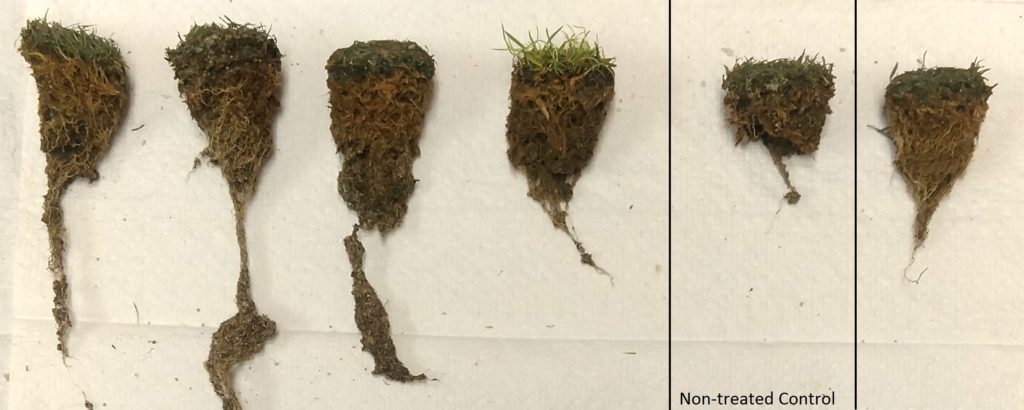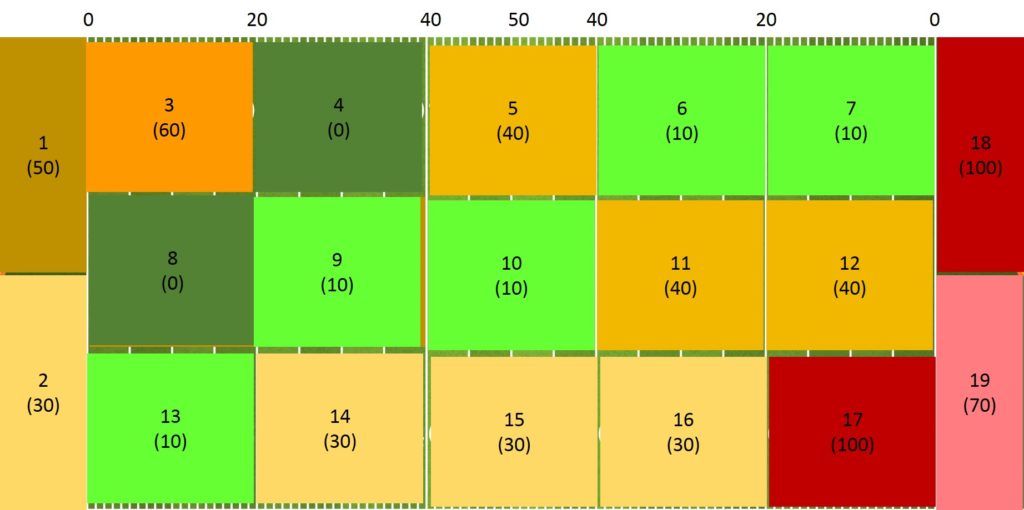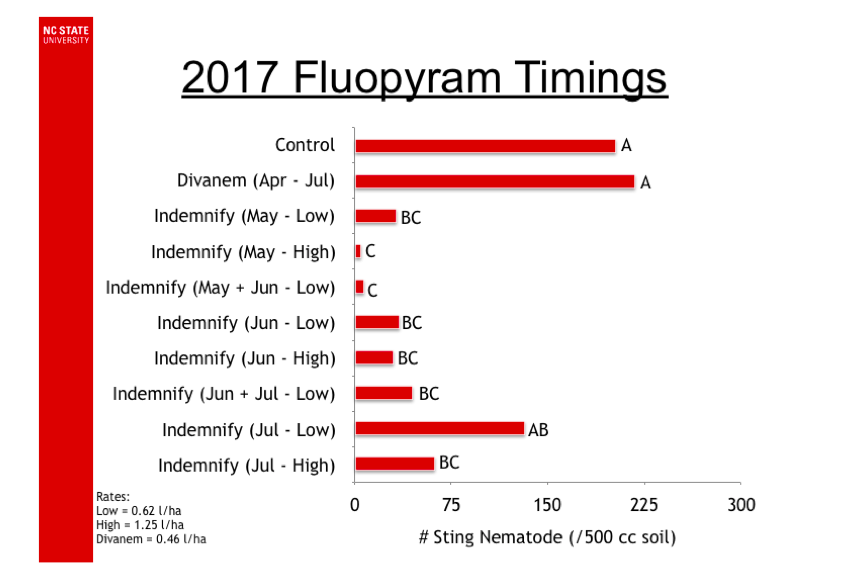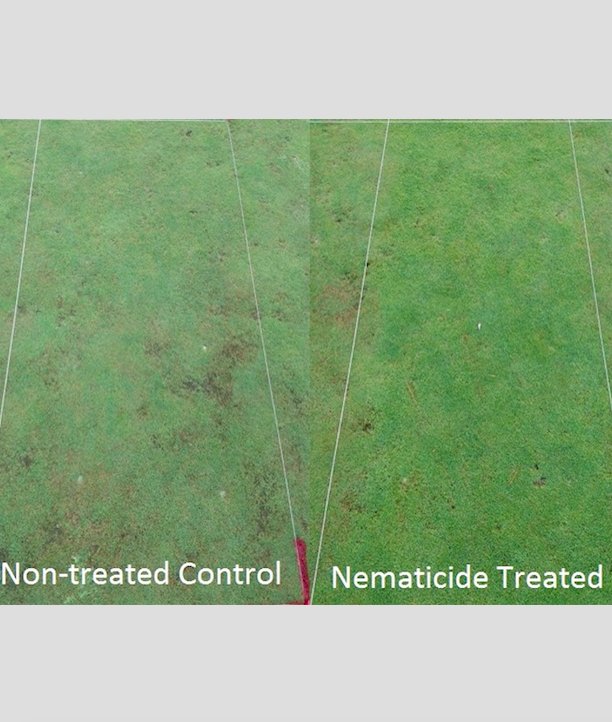By Glenn Galle and Jim Kerns, Ph.D.
Nematodes are the most abundant animals on the planet. Only a few are plant parasites, but they can be destructive. A recent survey of nematode genera showed that there were 23 different genera of nematodes associated with turfgrasses. However, the most damaging are typically sting, lance, root-knot, stubby root and stunt nematodes. For the purpose of this article we will focus on sting nematode as it is a common problem for athletic fields in the southeastern United States.
Sting nematode (Belonolaimus longicaudatus) is a large ectoparasitic nematode that feeds with a long stylet. It is a problematic parasitic on all species of turfgrass, and is found on golf courses, sod farms, and home lawns, as well as athletic fields. Nematode populations as low as 1-19 nematodes per 500cc of soil can cause severe damage to roots. Prescription athletic turf (PAT) systems are constructed with 11 to 20 inches of sand, which is an excellent environment for sting nematode, as it prefers soils with 80% sand or more. Moreover, many athletic fields are vegetatively propagated and can become infested with nematodes.
Symptoms
Sting nematode feeding damage manifests itself in both above- and below-ground symptoms. Above-ground symptoms typically include thinning, wilting or death of turfgrass. These symptoms usually occur in irregularly shaped patches, and slowly increase in size and severity if left unmanaged. Below-ground symptoms on turf include short, stubby root systems. Dark lesions on roots are also a symptom of nematode feeding damage. Sting nematode targets the root tips while feeding, resulting in a blunted root system with limited feeder roots.

Diagnosing nematode issues from stand and plant symptoms alone is challenging. Stand symptoms often mimic abiotic stresses such as heat or drought stress because the weakened root system cannot access water and nutrients. Suspected areas of heat and/or drought stress that do not respond to supplemental irrigation or fertility may have an underlying nematode issue. Without nematode sampling, proper diagnosis of nematode issues is difficult.
Sampling
Sampling is a requirement to determine how best to manage nematode issues on athletic turf. The sampling report will include the nematode species present, as well as population counts – both of which are important for determining management practices. Nematode identification is crucial, as different nematode species can cause different issues or react differently to nematicide applications. For example, sting nematode is a very damaging species and needs to be managed immediately if detected, whereas other species, such as ring nematode, only cause severe issues when populations are extremely high.

Population counts are important in determining the extent of damage expected, and can be useful in deciding how aggressive to be in management. The population counts will often be accompanied by a population threshold number. This threshold number is the minimum amount of nematodes necessary in a soil sample where nematode damage symptoms are likely to occur. Sting nematode is highly damaging at low numbers (1-19 nematodes/500cc soil), and therefore low population counts should be treated as aggressively as possible. Other species of nematodes may be present, but if their populations do not exceed the damage threshold, symptom development may not occur, or they may be minor and likely only require supplemental irrigation and fertility for management.
Sampling should be performed if a nematode issue is suspected in a turfgrass stand. The area to be sampled should first be split into manageable sections. Too large of an area will result in a diluted sample. Sections of 2,000-5,000 ft2 is a good size to take a sample from. Ten to 20 soil cores should be taken with a 1-inch-diameter soil probe randomly throughout the section (a zigzag pattern is a useful method). Cores should be taken no deeper than 6 inches. The cores are combined into a plastic bag, and must be treated carefully. Nematodes are very fragile, and are highly sensitive to heat. Keep the sample cool, and immediately send in the sample for counting and identification. Temporary storage in a refrigerator is possible, but should not exceed two to three days. Check with your local turfgrass extension specialist for potential nematode assay laboratories.
Cultural control
The use of cultural control methods to reduce the stress on turfgrass is very important, particularly during the summer months. Cultural control methods are unlikely to reduce nematode population numbers, but help the turfgrass to tolerate feeding damage when stressed. Most cultural practices for nematode feeding pressure aim at increasing the root system.
Irrigation:Follow irrigation requirements listed for each turfgrass species in each state. Most university turfgrass programs have management calendars or recommendations for irrigation amounts to sustain excellent turf. Over and under watering will promote a shallow root system, which could also promote nematode damage. Our research has shown that periodic use of soil surfactants helps with minimizing nematode damage, and also assists with infiltration of nematicides into the root zone.
Fertilization:Nitrogen fertility is very important for turfgrass stressed by nematode feeding. Supplemental nitrogen applications may be necessary to increase root growth. Remember, nematodes feed on the roots, which could impair nutrient uptake; thus, increasing N rates is an excellent way to overcome nematode damage. As mentioned, nematodes are the most abundant animals on the planet, and are present in every turfgrass system. Swards with limited nutrient holding or management styles that limit nitrogen can enhance nematode damage.
Aeration:Regular aeration is necessary for robust root systems. By allowing more space for roots to grow and increased oxygen availability to the roots, turfgrasses can sustain root systems to counter the loss of roots to nematode feeding. To minimize the disruption of the playing surface, regular venting (solid tine aerification) can help, or machines such as the A2G2 could also help sustain rooting in an athletic field.
Chemical control
Chemical control products may be required to manage nematode populations and reduce their impact on turfgrass. Application of nematicides is recommended from March-June. Applications should not occur until the soil temperatures reach 50○ to 60○F.
One of the most effective products for management of sting nematode is Indemnify (fluopyram). Timing is critical for this product, and applications should be made in May and possibly October to manage sting nematode. Our research clearly shows that sting nematode populations increase on bermudagrass and creeping bentgrass in April and May, and are within the top 2 inches of soil. Nematode populations continue to increase during the summer months, but most of the population is below 2 inches, making it challenging to get a nematicide to them. In sand-based systems, it is difficult to move fungicides and nematicides past the top 2 inches of soil, even with immediate post-application irrigation. Therefore, applications in June, July and August are likely to be ineffective, as feeding has occurred on any new roots and the nematodes are deep in the soil escaping nematicide applications. However, in October, nematode populations come back up into the top 2 inches of soil, and nematicides are effective again.

Applications rate can vary depending upon the severity of the nematode issue. With extremely high population (>100 nematodes/500cc soil), the highest rate of 17.1 fl. oz./acre is necessary to reduce the initial population in the spring. With lower population counts, the lower rate of 8.5 fl. oz./acre may be sufficient at reducing populations. A second application is beneficial in September or October at reducing populations during the fall and into the winter.
Glenn Galle is a Ph.D. student at NC State University who has successfully defended his Ph.D. dissertation. His work focused on the biology and management of sting nematode in golf course putting greens.
Jim Kerns, Ph.D., is an associate professor and extension specialist of turfgrass pathology, NC State University, Department of Entomology and Plant Pathology. His program focuses on diseases of both warm- and cool-season turfgrasses. Specifically the program is currently researching how fungicides move in sand-based rootzones after post-application irrigation, sting nematode biology and management, Pythium root rot biology and management and take-all root rot of ultradwarf bermudagrass etiology and epidemiology.
Top image: An example of the damage sting nematode can do to a putting green. The image on the left shows a severe reduction in turf quality, including turf death in several areas. When nematode feeding is managed with a nematicide, damage can be reduced and turf health can be maintained.


